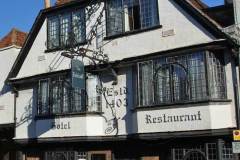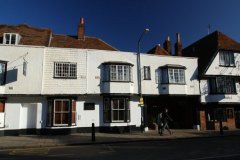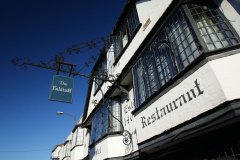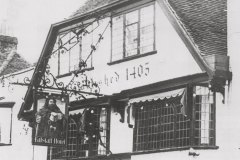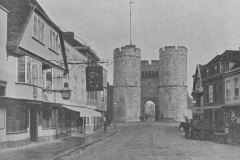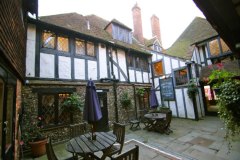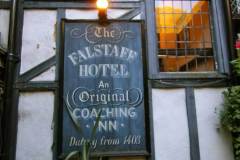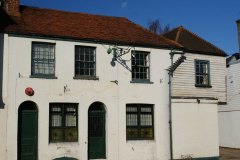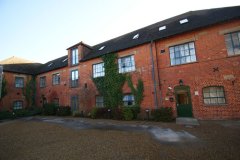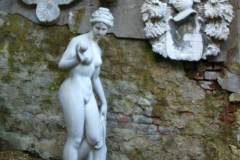8-10 St Dunstan’s Street
Introduction
Since it is just outside the Westgate, the main entrance to the city from London, this hotel was probably originally built to accommodate pilgrims and travellers who arrived after the curfew and were unable to enter the city that night.
History
On the front of the hotel is a sign stating it was established in 1403, but we know it has been heavily restored over the centuries. In the 16th and 17th centuries we know it was the “White Hart” from the accounts of the wardens of the Holy Cross church adjacent to Westgate who mention that vestry meetings were held there (The vestry was the lay governing body of the parish in the 16th and 17th centuries). The building underwent extensive renovation during the 17th and 18th centuries including an entrance for horse drawn carriages to the rear courtyard where there was access to a Tap public house for the ostlers and servants on North Lane . In 1783 it was renamed the Falstaff Inn, no doubt to exploit the rising popularity of Shakespeare’s fat, vain, boastful, and cowardly knight who first appeared in “The History of Henry IV”. The building was listed in 1949 and in the 1990’s the Tap and an old wood mill building were converted to provide more bedrooms.
Due to its position just outside the city gates the inn has served as a convenient starting point for a number of “sporting feats”. In September 1787 a Mr Foster Powell then aged 51 was bet 25 guineas (£1600 in today’s money) that he could not walk from Canterbury to London Bridge and back (112 miles) in less than 22 hours. He succeeded with several minutes to spare. On 6th May 1819 a horse dealer named Mr Hutchinson wagered 600 guineas (£26,400 in today’s money) that he could ride to London Bridge in 3 hours with 11 changes of horse. He succeeded in a time of 2 hours 25 minutes.
What to see:
- The timber framed main building with a brick, mathematical tile and plaster facade containing the establishment date of 1403, two 17th century 1st floor bay windows with arched transoms and a half-hipped tiled roof (Image1).
- The extended hotel of today showing the surviving entrance for horse drawn coaches, now the reception area (Image 2).
- The elaborate 18th century wrought iron sign bracket with the current sign (Image 3) and that of the late 20th century (Image 4) which compare badly with a much larger one with a boisterous image of Falstaff of the 1930s, which also retained its lantern (Image 5).
- The surviving rear courtyard (Image 6) and sign (Image 7).
- The old Tap public house in North Lane with its iron bracket remaining (Image 8) and the wood mill (Image 9), both now converted to bedrooms .
- Romanesque carvings in the courtyard of elven grotesque heads salvaged from a local ecclesiastical building before the 18th century (Image 10).
Access: The building can be viewed from the street at all times but access to the interior is limited to guests.
Sources: Egan (1820); Lyle (2008); noticeboards on site
http://www.britishlistedbuildings.co.uk/en-441024-the-falstaff-hotel-8-10-canterbury
KW/SR

